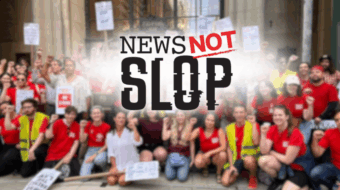
CHICAGO – Thousands of transit workers and passengers rallied at the Rainbow PUSH Coalition (RPC) on March 27 to demand federal funding for public transit systems nationwide.
“This is a national transit crisis,” declared Rev. Jesse Jackson, president of RPC. “We say rebuild rail, make the steel in Gary, Birmingham and Pittsburgh. Make the buses in Detroit. Make the windmills in Indiana. Put American back to work now.”
Transit worker unions and RPC are forming a national coalition to save public transit and union jobs. The rally was the first in a national tour to unite transit workers with the communities they serve.
While the American Recovery and Reinvestment Act of 2009 allocated nearly $50 billion for surface and transit projects, including $8 billion for high speed rail construction, the recently passed Jobs for Main Street Act was mostly stripped of mass transit funding.
Jackson railed against federal and state policies, mostly written over the years by Republican legislators, which have choked funding for urban transit. Services cuts and layoffs are especially impacting working-class, poor, African American, Latino and other communities of color.
Layoffs are also disproportionately hitting workers of color, and eliminating good paying union, family-sustaining jobs.
The coalition is demanding immediate passage of legislation by Rep. Russ Carnahan, D-Mo., that would allow cities over 200,000 to use up to 50% of their federal transit funding for operating expenses.
Unions are also demanding federal and state funding ratios be changed. For example the Chicago area Metra system, which mainly services the suburbs around Chicago, gets five times more funding per passenger than the Chicago Transit Authority (CTA).
The CTA laid-off 1,100 transit workers Feb. 7 to close a $300 million budget deficit. The cuts resulted in the elimination of bus lines, longer wait and packed buses and trains.
But Chicago is not alone. According to the American Public Transit Association (APTA), 90% of large transit agencies have been forced to raise fares or cut services and lay off workers in the last few years.
The Metropolitan Transit Authority in New York City is facing an $800 million deficit and may lay-off 1,300 workers. Washington DC transit officials will lay off 150 workers to close a $40 million gap. Trains are already bursting at the seams with passengers.
The Chicago rally brought together leadership from Amalgamated Transit Union (ATU), Transport Workers Union and United Transportation Union.
“We’re talking about creating a new economy, but at the same time local governments are dismantling our transit system,” said Harry Lombardo, Executive Vice President of the Transport Workers Union.
“They’re bailing out Wall Street, bailing out the banks and auto industry but letting transit die. It makes no sense,” he added.
“I bring the solidarity of 38,000 New York City transit workers,” declared John Samuelson, president of the Transport Workers Local 100 of New York City to cheers. “Our message is simple: we stand together, we win. We stand alone, we lose.”
APTA says there are $15 billion in public transit projects “shovel ready” and should be included in any federal jobs legislation. This would create 450,000 jobs. For each $1 invested in public transit, $6 is generated in economic return. A $1 billion investment in public transit would create 30,000 jobs.
According to Tyrone Jordan, bus operator and ATU Local 241 member, the layoffs are overworking the remaining workers. The money to solve the crisis has to come from the government, he said.
“They’re cutting mass transit everywhere,” said Vern Hodge, abus operator and union rep for ATU Local 241. “We’re here to put up a fight for more funding.”










